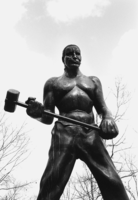 | Back to e-WV
| Back to e-WV
 The West Virginia Encyclopedia
The West Virginia Encyclopedia
 | Back to e-WV
| Back to e-WV
 The West Virginia Encyclopedia
The West Virginia Encyclopedia

John Henry was a legendary steel driving man, whose life is the basis for one of the world’s best-known folk tales. His fame rests on a single epic moment when he raced the steam drill during the building of a West Virginia railroad tunnel. That moment has captured the imagination of balladeers and storytellers for the last century, and in their songs and tales they have woven for John Henry a whole life: an infant’s prophecy, a woman he loves, a heroic test, and a martyr’s victory.
Scholars cannot know the real contours of John Henry’s life. He was probably born a slave and was perhaps a convict after emancipation. He worked between 1870 and 1872 as a hammer man or steel driver during construction of the Big Bend (or Great Bend) Tunnel, on the Chesapeake & Ohio Railroad near the Greenbrier River in Summers County. These men used sledge hammers to drive long steel bits into treacherous red shale to bore the holes for the explosives that would open the tunnel.
In the ballad John Henry exhorts his ‘‘shaker,’’ the working partner who clutched, rotated, and shook the dust from his drill: ‘‘Shaker, you better pray. If I miss this piece of steel, Tomorrow be your buryin’ day.’’ Their work was arduous, hazardous, and labor-intensive. Many died from bungled blasting, crashing rocks, and tunnel sickness or silicosis.
Scholars suspect that Capt. W. R. Johnson, contractor for Big Bend, hoped to import the Burleigh Steam Drill to replace human steel drivers. He may have organized a contest between the drill and his best human driver. Declaring, ‘‘A man ain’t nothin’ but a man,’’ John Henry took up the challenge. He won the race, but overexerted himself and died, mourned by his woman, often called Polly Ann, and an infant son who appears destined to follow his father as ‘‘a steel-drivin’ man.’’ An anonymous musician, possibly a fellow worker, composed a song, which has since been performed in countless variations.
Drawing on this original ballad, many work songs, blues songs, and ballads commemorate John Henry, and he has inspired children’s books, tall tales, folk art, sculpture, film, and theater. In popular culture he grew to represent an African-American hero of quiet, steadfast resistance, a labor hero who fought to protect the dignity of work and the value of humanity over machines, and a Southern hero withstanding slippery Yankee commodities.
The man behind the folkloric giant is elusive, and some doubt the existence of John Henry as a historic figure. In the early 20th century, scholars Guy Johnson and Louis Chappell tried to uncover biographical details. They interviewed tunnel workers and their descendants, and publicized their efforts to find the trail of John Henry, but neither fully succeeded. Building upon their research and expanding it through other historical records, one concludes that a man like John Henry in fact beat the steam drill, accomplishing the triumph that music accords him.
In 1972, a statue of John Henry was placed on the hillside above the entrance of Big Bend Tunnel. In 2012 the statue was restored and relocated closer to the tunnel entrance as part of the future John Henry Historical Park in Talcott. The park will celebrate the legend of John Henry and local railroad history.
Written by Brett Williams
Chappell, Louis W. John Henry: A Folk-Lore Study. Jena, Germany: Frommannsche Verlag, W. Biederman, 1933, Reprint, Kennikat Press, 1968.
Johnson, Guy B. John Henry: Tracking Down a Negro Legend. New York: AMS Press, 1969.
Williams, Brett. John Henry: A Bio-Bibliography. Westport, CT: Greenwood Press, 1983.